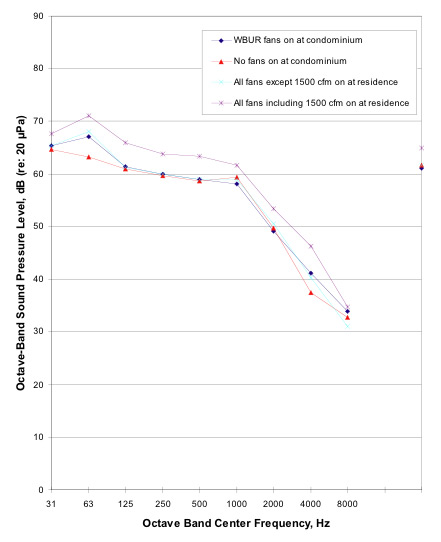Neighbors near the PAX television transmitter in Needham, Mass. were complaining about fan and equipment noise associated with the facility. DCC visited the television transmitter site on October 6, 2005. The purpose of the site visit was to measure the noise produced by the equipment for comparison with relevant criteria and to determine the highest contributors of sound at the nearby condominium.
DCC measured equipment noise associated with several different equipment scenarios: 1) PAX pad only noise, 2) WBUR equipment only, 3) WBUR equipment and new condenser, 4) WODS equipment only, and 5) new PAX 1500 cfm fans. For each of these scenarios, DCC measured noise at distances of 10 and 20 feet away from the equipment to determine the distance attenuation rate.
In addition, DCC measured noise associated with these scenarios at the nearby condominium. Traffic noise from nearby Route 128 is quite prominent at this location, and therefore it is not possible to completely isolate and separate out the contributions of the different equipment scenarios by noise measurements alone. However, it is possible to extrapolate the scenario contributions to this location based on the measured distance attenuation rates.
Figure 1 shows measured spectra of all equipment, no equipment, WBUR fans, and the new 1500 cfm PAX fans at the condominium location. The 1500 cfm fans were clearly audible at this location, evident by how the spectrum exceeds the ambient noise spectrum. With all fans except the 1500 cfm fans running, it was d ifficult to distinguish fan noise from Route 128 vehicle noise. However, the data indicates that fan noise exceeds the ambient noise at 63 Hz. Late at night when Route 128 traffic noise dies down, fan noise would likely become more audible at this location.
Figure 1. Transmitter Fan Unit Noise Measurements

Based on measured distance attenuation rates, Figure 2 shows extrapolated fan noise contributions at the condominium location. The logarithmic sum of the individual fan contributions is within reasonable agreement with the total measured noise, so the individual fan contribution extrapolations are reasonably accurate. This data shows that the pad equipment noise is the largest contributor, the next largest is the WBUR fans, and the lowest contributor is the WODS fans. However, the WBUR new added condenser produces the 250 Hz peak shown in the data, which is more noticeable than broad-band fan noise.
Figure 2. Transmitter Fan Unit Noise Measurements, Extrapolated Fan Noise

DCC performed noise measurements over a twenty four-hour period at the condominium location using an automated noise monitor. This information can be helpful to show how noise levels change over that time period as well as for comparison with noise criterion such as the Day Night Average Noise Level (DNL). The DNL is essentially a 24 hour average with a 10 dBA nighttime noise penalty. Figure 3 shows the results of these measurements. The lowest hourly Leq value is 56 dBA which occurs around 3 am. That noise floor is very likely due to the equipment pad noise, because the A-weighted value of the extrapolated pad noise spectrum shown in Figure 2 is 56 dBA (The logarithmic sum of all three contributors is actually 58.8 dBA. The difference between this value and 56 dBA can easily be explained by additional attenuation caused by the intervening ridge and vegetation.). The higher noise levels during the day—up to 67 dBA-- correspond with Route 128 noise. The total DNL at this location is 66 dBA. This value exceeds acceptable criteria for residential use according to HUD, FHWA, and ANSI. Highway noise is the dominant noise source at this location and causes overall noise levels to exceed these criteria.

Table 1 shows estimated extrapolated noise contributions of the three noise sources, at the condominium location.
Table 1. Extrapolated Noise Contributions of Fans at Condominium

The Boston Noise Code requires noise levels to be less than 60 dBA during the day and 50 dBA at night. Arguably, the fan noise should be mitigated to be below 50 dBA at night. However, this situation is unusual because fan noise is masked by highway noise many hours of the day. In addition, reducing fan noise will not reduce the overall DNL at this location.